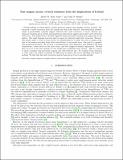Files in this item
Fast magma ascent, revised estimates from the deglaciation of Iceland
Item metadata
| dc.contributor.author | Rees Jones, D. W. | |
| dc.contributor.author | Rudge, John | |
| dc.date.accessioned | 2021-05-17T23:51:01Z | |
| dc.date.available | 2021-05-17T23:51:01Z | |
| dc.date.issued | 2020-07-15 | |
| dc.identifier | 267818112 | |
| dc.identifier | 6adb3e96-b1bb-4a89-8742-52862ba8b644 | |
| dc.identifier | 000537625600020 | |
| dc.identifier | 85084650614 | |
| dc.identifier.citation | Rees Jones , D W & Rudge , J 2020 , ' Fast magma ascent, revised estimates from the deglaciation of Iceland ' , Earth and Planetary Science Letters , vol. 542 , 116324 . https://doi.org/10.1016/j.epsl.2020.116324 | en |
| dc.identifier.issn | 0012-821X | |
| dc.identifier.other | ORCID: /0000-0001-8698-401X/work/74510441 | |
| dc.identifier.uri | https://hdl.handle.net/10023/23211 | |
| dc.description | Authors thank the Leverhulme Trust for financial support. | en |
| dc.description.abstract | Partial melting of asthenospheric mantle generates magma that supplies volcanic systems. The timescale of melt extraction from the mantle has been hotly debated. Microstructural measurements of permeability typically suggest relatively slow melt extraction (1 m/yr) whereas geochemical (Uranium-decay series) and geophysical observations suggest much faster melt extraction (100 m/yr). The deglaciation of Iceland triggered additional mantle melting and magma flux at the surface. The rapid response has been used to argue for relatively rapid melt extraction. However, this episode must, at least to some extent, be unrepresentative, because the rates of magma eruption at the surface increased about thirty-fold relative to the steady state. Our goal is to quantify this unrepresentativeness. We develop a one-dimensional, time-dependent and nonlinear (far from steady-state), model forced by the most recent, and best mapped, Icelandic deglaciation. We find that 30 m/yr is the best estimate of the steady-state maximum melt velocity. This is a factor of about 3 smaller than previously claimed, but still relatively fast. We translate these estimates to other mid-ocean ridges accounting for differences in passive and active upwelling and degree of melting. We find that fast melt extraction greater than about 10 m/yr prevails globally. | |
| dc.format.extent | 9 | |
| dc.format.extent | 961397 | |
| dc.language.iso | eng | |
| dc.relation.ispartof | Earth and Planetary Science Letters | en |
| dc.subject | Magma migration | en |
| dc.subject | Magma velocity | en |
| dc.subject | Mid-ocean ridges | en |
| dc.subject | Iceland | en |
| dc.subject | Deglaciation | en |
| dc.subject | GE Environmental Sciences | en |
| dc.subject | QA Mathematics | en |
| dc.subject | DAS | en |
| dc.subject | BDC | en |
| dc.subject.lcc | GE | en |
| dc.subject.lcc | QA | en |
| dc.title | Fast magma ascent, revised estimates from the deglaciation of Iceland | en |
| dc.type | Journal article | en |
| dc.contributor.institution | University of St Andrews. Applied Mathematics | en |
| dc.identifier.doi | 10.1016/j.epsl.2020.116324 | |
| dc.description.status | Peer reviewed | en |
| dc.date.embargoedUntil | 2021-05-18 | |
| dc.identifier.url | https://arxiv.org/abs/1910.08318 | en |
This item appears in the following Collection(s)
Items in the St Andrews Research Repository are protected by copyright, with all rights reserved, unless otherwise indicated.

